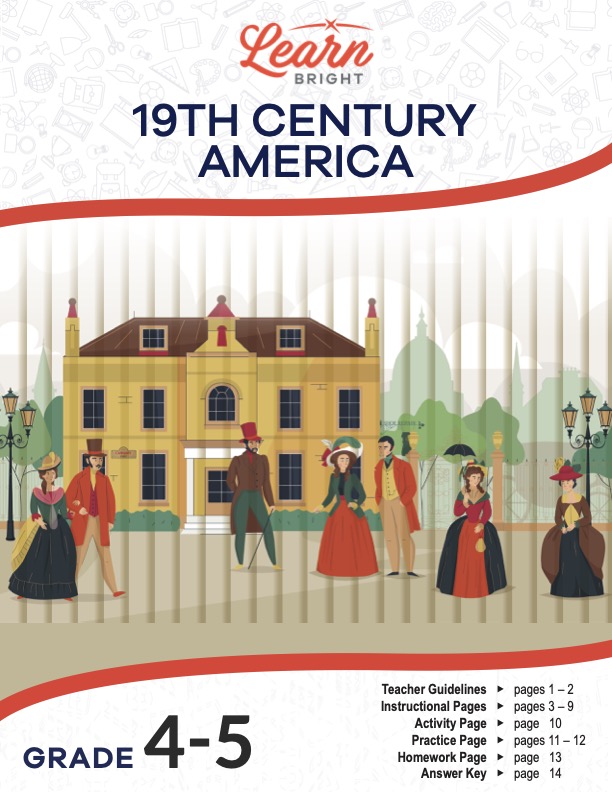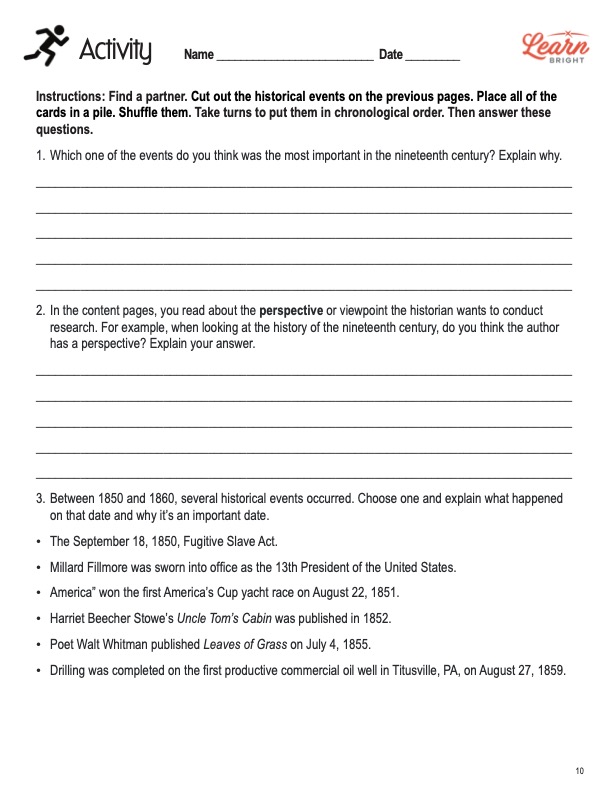Description
What our 19th Century America lesson plan includes
Lesson Objectives and Overview: 19th Century America describes many historical events from this period that foreshadow current events. Students will discover how historians use chronological events to describe a specific period in history. They will also recognize the importance of interpreting historical events within the context of the time of the event. This lesson is for students in 4th grade and 5th grade.
Classroom Procedure
Every lesson plan provides you with a classroom procedure page that outlines a step-by-step guide to follow. You do not have to follow the guide exactly. The guide helps you organize the lesson and details when to hand out worksheets. It also lists information in the yellow box that you might find useful. You will find the lesson objectives, state standards, and number of class sessions the lesson should take to complete in this area. In addition, it describes the supplies you will need as well as what and how you need to prepare beforehand.
Options for Lesson
There are suggestions in the “Options for Lesson” section of the classroom procedure page for additional activities or ideas. Allow students to dress in clothing similar to the styles from the 19th century. Assign an event, person, or invention from this century for students to write about and later present to the class. Organize a “History Fair” based on significant events and figures from the 19th century. Getting students interested in history can sometimes be a challenging task! One way to pique their interest is to divide them into teams to complete a WebQuest. These interactive adventures allow students to discover interesting parts of history and learn critical thinking skills as they work in teams to complete the assignment. Here is one example of a WebQuest that takes students back in time. America in the 19th Century: https://sites.google.com/a/uni.edu/bensoeacwebquest/
Teacher Notes
The teacher notes page provides an extra paragraph of information to help guide the lesson. You can use the blank lines to write down any other ideas or thoughts you have about the topic as you prepare.
19TH CENTURY AMERICA LESSON PLAN CONTENT PAGES
Understanding History
The 19th Century America lesson plan has seven pages of content. At this point, you have probably learned a lot of stuff from history. Unfortunately, sometimes it seems like you have to memorize endless facts and dates and uninteresting stories that have little to do with your present life. Other times, you learn something dramatic and surprising. However, there is little doubt that you have thought about why you learned this stuff about the past. You can’t change the past, and it appears to have no connection with the present.
Historians will tell you that if you think this way, you have a misconception, or the wrong idea, about the importance of studying the past. Nearly every invention, innovation, or idea begins with someone in the past and builds into what it looks like in the present. Historians study history to discover why things are the way they are today or to improve the quality of life for people in the present. Some say the past is the key that unlocks the present and future door!
So, how do historians study the past? There are many ways, which we call historical methods. Some involve studying cause and effect through events. Others involve the study of writings of people who lived during a certain time. Historical documents and primary sources like journals, newspapers, and eyewitnesses are other ways historians look at historical events. Finally, many historians like to group history by decades or centuries.
To recap, there are many reasons to study history, such as the following:
- Understand other cultures
- Understand the lessons from the past
- Understand the effects of change on society
- Understand our present-day culture
- Understand our civic duties
- Understand how to analyze complex ideas and concepts
- Understand how people in the past can inspire us to be better in the present
Events on a Time Line
One way is to organize events in chronological order or according to the time they happened. Then we can look to see how one event may relate to another. Are the same people involved in the circumstances? For example, take the American Revolution. Six of the signers of the Constitution signed the Declaration of Independence. It’s not too difficult to think that the experiences of the six who signed the Declaration of Independence influenced their writing of a new Constitution!
Knowing something about the 1700s contextualizes what the new nation was like. The 19th century began in 1800. Recall from your history that the American Revolution ended in 1783. Next, the government ratified the Constitution in 1788. The new American government started a year later. Finally, in 1791, the District of Columbia and Washington became the federal government’s official capital.
By 1800, the federal government was still in its infancy. However, it started gaining more influence in the affairs of regular Americans. Most of the American continent remained unexplored and unsettled. Not to mention, much of it still belonged to other European countries.
When organizing by chronological order, one difficult decision we must make has to do with which events are important enough to include. After all, there is something every day that some might consider historically important. But including events from every day would be nearly an impossible task! So how do historians decide what is important enough to include?
It depends on the perspective or viewpoint from which the historian wants to conduct research. For example, if a historian is interested in politics, they organize the history by significant political events like elections. On the other hand, historians interested in popular culture might study fashion trends or sports. Historians are free to research history from any perspective that interests them!
19th Century America Time Line
The lesson then offers a few pages of events that are significant to the history of the U.S. during the 1800s. For instance, Thomas Jefferson was elected president of the United States. The election signaled the rise of political parties. Interesting fact: Jefferson and Aaron Burr had the same number of electoral votes due to an outdated amendment in the Constitution. The House of Representatives decided the election, where each state wielded a single vote.
In 1812, the United States found itself at war (once again) with Great Britain. The war was largely over Britain’s desire to restrict trade between the United States and other European nations like France. At this time, Great Britain had the world’s best navy and was the dominant military power in the Atlantic. One of the tactics they used that particularly irked Americans was forcing American seamen to become part of the British Navy when they seized American ships. The war ended in 1814 with the Treaty of Ghent. Most historians believe neither side won the war.
Jump ahead to January of 1848. A carpenter found flakes of gold in the American River while constructing a mill for John Sutter. News of the discovery of gold rapidly spread across the United States, and the California Gold Rush began. In 1848, the non-native population of California was likely around 1,000 people. By the end of 1849, more than 100,000 people flooded into the state to seek their fortunes and mine gold. The Gold Rush ended around 1852, but not before thousands of people made their residence in California permanent. Dozens of new towns sprang up around the mines.
Students will use the events on these content pages for the following worksheets. You can, if you so choose, add more events that you want students to learn about. You can also have them search for ones that are not on the list already to add to the pile for the activity. Keep in mind, however, that they will create additional events for the practice worksheet.
19TH CENTURY AMERICA LESSON PLAN WORKSHEETS
The 19th Century America lesson plan includes three worksheets: an activity worksheet, a practice worksheet, and a homework assignment. Each one will help students solidify their grasp of the material they learned throughout the lesson. You can refer to the classroom procedure guidelines to know when to hand out each worksheet.
TIME LINE GAME ACTIVITY WORKSHEET
Students will work with a partner for the activity. They will cut out the historical events from the previous content pages and shuffle them in a pile. Then they will take turns taking an event and placing it in chronological order. After they finish with the time line of events, students will answer the prompts on the worksheet.
FIVE IMPORTANT EVENTS PRACTICE WORKSHEET
For the practice worksheet, students will write about five events they think are important. They will first choose a date range that the page lists and choose events from that range. Then they will write about the events on index cards and place them in chronological order along with the events from the activity. Finally, they will make boards or large posters of their events. They should include photos with their board.
19TH CENTURY AMERICA HOMEWORK ASSIGNMENT
The homework assignment requires students to build on what they did for the practice. Students will choose one of the historical perspectives from the list on the page. Using index cards, they will describe five more events within that perspective.
Worksheet Answer Keys
There are “answer keys” for the practice and homework worksheets at the end of the document. However, given the nature of the prompts on both worksheets, the answers on the key are suggestions or guidelines. If you choose to administer the lesson pages to your students via PDF, you will need to save a new file that omits these pages. Otherwise, you can simply print out the applicable pages and keep these as reference for yourself when grading assignments.









